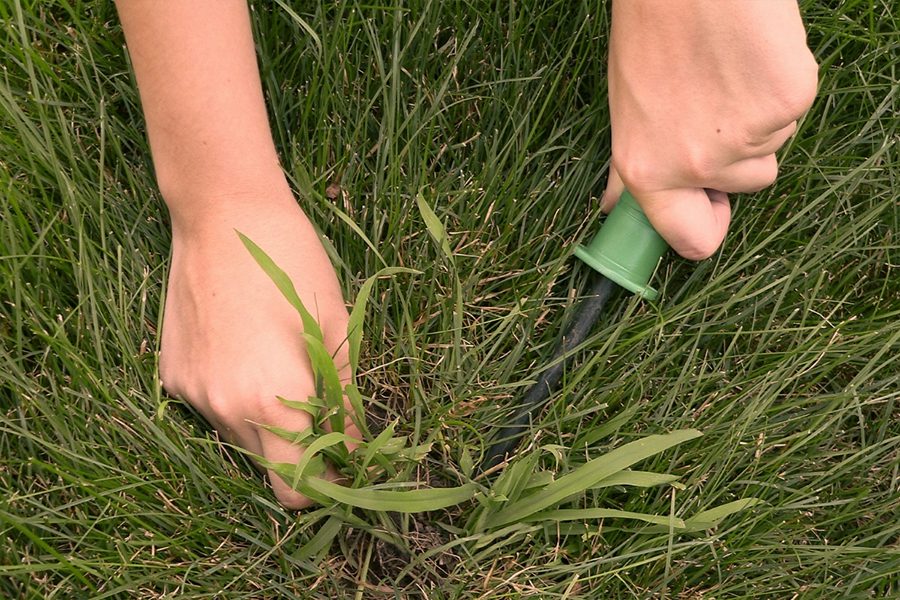When spring arrives, you can almost feel the collective joy of gardeners the world over, who have spent the winter waiting for the weather to change. Luscious leaves return to trees, blossoms emerge, and grasses start to show through the soil. But when the beautiful greenery returns to our gardens, it’s also joined by weeds. And the dastardly crabgrass is one of the most difficult to deal with.
In this post, we take a comprehensive look at crabgrass, understand what it is and where it comes from. And most importantly, we examine different ways in which you can kill it and focus on keeping your garden beautiful.

Related: How to Get Rid of Clover
What is crabgrass?
Crabgrass, also known in different parts of the world as Digitaria, finger-grass, and fonio, is a genus of plants in the grass family. Crabgrass is native to tropical regions but can now be found in subtropical and colder areas.
One of the reasons for its spread is that it begins to germinate when soil temperatures reach 55 degrees Fahrenheit. Therefore, in most countries, it starts to appear with the onset of spring or even summer, and it begins to spread like wildfire if it’s left untreated.
Crabgrass is an unfathomably robust weed, as un-germinated seeds can stay in the soil a remarkable thirty years before sprouting! Moreover, a single crabgrass weed has the capacity to produced more than 150,000 seeds during one season.
Is crabgrass really that bad?
It’s crucial to acknowledge at the start that for a new generation of gardeners, weeds like crabgrass aren’t actually a problem. Many indeed take great pride in the fact that their gardens run wild, as it is the perfect condition for nature to return. Bees and small animals love unruly gardens, so some people just let things grow and are happy to watch nature take its course.
However, for many, weeds like crabgrass are the bane of our lives, and we spend far too much time trying to kill it. This article is really for us who take pride in our beautiful manicured lawns and don’t want our grasses infested by weeds like crabgrass.
The most significant problem that crabgrass presents is the speed at which it proliferates. We will touch on this in the section below, but if we don’t work to control it, then our lawn is really at its mercy!
With this in mind, it’s straightforward to understand why crabgrass presents a significant challenge to gardeners worldwide and why it’s so difficult to control and contain. Before we look at how to remove crabgrass from your garden, let’s understand the conditions in which crabgrass thrives.
In what conditions does crabgrass thrive?
As has already been mentioned, crabgrass can grow in most places where there is grass, but it prefers certain conditions to others, and like all other weeds, it thrives when conditions are in its favour. Combatting these conditions is often the first step to killing crabgrass and removing it from your garden.
Crabgrass tends to prefer compacted soil where the grasses surrounding it are weak. It also spreads quickly where sand is present, which is why crabgrass is a particular problem in parts of the US where the desert meets the city.
It’s rare to see a lawn that is bare and thin without seeing crabgrass present too. This is because there is little protection from tall grasses, and sunlight can directly penetrate the ground, meaning the soil is heated more quickly. This then becomes the ideal breeding ground for crabgrass.
Another factor that helps crabgrass thrive in your lawn is the water and phosphorous levels of your grasses. Like all weeds, crabgrass likes lawns with an excess of both water and phosphorous, so maintaining these levels can help combat the growth of crabgrass and other weeds in the long-term.
Although containing weeds like crabgrass can seem incredibly daunting, if you understand the conditions in which it thrives, you can at least implement some simple, cost-effective techniques that will help to prevent the spread of crabgrass before it takes over your garden. Let’s move on to look at ways in which we can prevent crabgrass from taking over our lawns.
Can we prevent crabgrass before it becomes a problem?
The good news is that yes, we can take specific measures to prevent crabgrass from taking over our lawns. One of the main ways in which you can prevent crabgrass is by maintaining a healthy lawn throughout the year. Crabgrass loves bare, warm soil, so if you can water your lawn and keep it healthy, you reduce the risk of crabgrass popping up in the spring.
Applying nutrient-rich fertiliser regularly to your lawn supports your grasses to grow regardless of the weather and can be an excellent way to offset the arrival of those pesky weeds. Replacing dry patches of lawn with new pieces of turf where possible is also really helpful, as it is from these patches that crabgrass emerges and begins its takeover.
In addition to these natural lawn care methods, you can also prevent the spread of crabgrass by treating your lawn with specific pre-emergent chemicals. However, don’t fall into the trap of misusing the chemicals, as this could spell disaster for the health of your lawn in the long-run.
In order for pre-emergent chemicals to be useful, timing is paramount. You need to monitor your soil’s temperature and only apply the chemicals when the soil is reaching 55 degrees Fahrenheit, which is the temperature of optimal growth for crabgrass. You then need to apply the chemicals again approximately six weeks later.
There are lots of pre-emergent chemicals on the market, but some of the best include:
Sedge Ender Weed Control Concentrate
Having explored some ways in which you can try and prevent crabgrass from becoming a problem in your garden, let’s now look at ways in which you can kill crabgrass when it arrives in spring.
How can I kill crabgrass?
There are several ways that you can kill crabgrass and stop it from ruining your lawn. However, I believe it’s best to control your garden’s conditions in the lead up to spring to ensure you don’t need to arrive at this stage!
That’s easier said than done, though, and these dastardly weeds are so robust and long-lasting that we often need help to remove them. Below we explore some ways in which you can remove crabgrass from your garden.
Manually remove crabgrass
Perhaps a little time consuming, removing crabgrass by hand is probably the most environmentally friendly way of killing crabgrass. Removing crabgrass naturally also allows you to be selective and helps protect the grasses surrounding the weed.
Before you begin, make sure you water the area surrounding the crabgrass, as this makes it easier for you to prise it out of the soil. It’s a good idea to apply water for at least thirty to forty minutes before removing the weeds, as this gives the soil time to soften.
Once the soil has softened, grab your pitchfork or weed claw and begin to remove the crabgrass. Make sure you take all of the roots, and once you’ve removed it from the soil, apply some organic manure to the soil. Leave it for a short while, and then apply some lawn seed to the patch and water.
This straightforward manual process is an effective way to remove smaller crabgrass patches, but it’s labour intensive and requires a good weed claw. The following weed claw is a great product and available on Amazon:
Use a spot treat liquid
If you haven’t been successful in preventing crabgrass from arriving in your garden, and the manual method hasn’t worked, you could always try a spot treat liquid. This is an efficient way of removing clumps of crabgrass that is already established on your lawn.
Again, there are many useful products on the market, but make sure you find a lawn-safe herbicide that isn’t going to kill your grasses as well as the crabgrass. One of the best products on the market comes from Ortho and can be purchased on Amazon:
Ortho Weed B Gone Plus Crabgrass Control
Like with all herbicides and other chemicals, you don’t want to overuse it. During the spring and summer, head out onto your lawn to check for crabgrass patches and apply the spot treat liquid to the affected patch. It’s vital that you only apply the liquid when it’s dry to ensure the herbicide sticks to the grass blades.
Equally, if rain is forecast, hold off from applying. You also don’t want to mow your lawn too soon after applying, as you will remove the herbicide without allowing it time to do its job. As is the case with many weeds, removing crabgrass required patience, so apply the liquid and monitor in the coming days to see if it has been successful.
Use baking soda
Arguably the best home-based solution to the crabgrass problem is baking soda! Because it is a phytotoxin, it will damage pretty much any plant it comes into contact with. It would help if you were careful with baking soda because it is non-selective and will destroy every plant in its path.
It’s best to use baking soda sparingly and only on isolated patches. If your lawn is overgrown with crabgrass, then avoid baking soda altogether. Once you have identified an isolated patch of crabgrass, apply a little bit of water to the area. Sprinkle enough baking soda onto the crabgrass, so it’s covered. Leave it for a few days and then return. After it has worked its magic, remove the dead weeds and plant lawn seed.
Again, avoid mowing your lawn until the weeds are dead, and try not to apply baking soda during or before inclement weather.
Use corn gluten
Another home-based remedy to help remove crabgrass from your lawn is corn gluten. Organic and high in nitrogen, corn gluten is a useful product to help remove weeds from your garden in general but is particularly useful when killing crabgrass.
Corn gluten is sometimes mistaken as a preventive measure, but it only actually works to kill crabgrass. The basic premise is that corn gluten provides your soil with additional nitrogen, which helps the healthy grasses grown and stunts the growth of crabgrass, as it proliferates in sparse lawns that are bare and dry.
The use of corn gluten may not be effective on all lawns, but it’s undoubtedly an environmentally friendly way to remove crabgrass.
Conclusion: how to maintain a crabgrass free lawn
If you want to maintain a beautiful and well-manicured lawn throughout the year, you need to do your best to keep weeds from your garden. The first step to achieving this is to ensure your garden does not provide optimum growing temperatures for weeds like crabgrass.
This means you should treat your lawn throughout the year, keep it well watered and nutrient-dense to prevent dry and bare patches from emerging, as these are breeding grounds for crabgrass and other resilient weeds.
If crabgrass appears on your lawn in the spring or early summer, then there are many ways to remove it. If you see isolated patches, removing the crabgrass naturally or with a home-based remedy like corn gluten or baking soda could work.
If you have a more extensive infestation, you may need to resort to a shop-bought herbicide or spot treat liquid that will kill the crabgrass. It’s vital that once the weeds have been killed, you treat your lawn area and replant the grass. This way, you won’t have to worry about crabgrass returning immediately.







